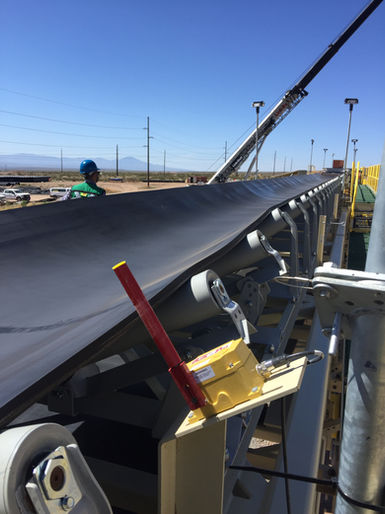
SERVICES

BELT
DIVISION
IN UNITED STATES OF AMERICA OUR MARKETS ARE
Aggregates, Sand and Gravel, Coal Mining, Oil Sands, Power Plants, Copper and Gold Mines, Chemicals and Fertilizers, Cement and Recycling.
-
Our technicians have over 10 years experience with certification in Fabric Belts and Steel Cord splicing belting services.
-
Complete installation of the system (head and tail pulleys, idlers, skirt, scrapers, splice belt, canyons).
-
Splice fabric belt widths up to 72” wide and Steel cable widths up to 72”
-
Belt Mechanical Fastenings by metal hinges or plates.
-
Repair damage of any belts in short times (we have a Spot Repair Press)
-
Track every system to prevent and correct any issue with anticipation.
WE CAN INSPECT AND OFFER SOLUTIONS IN YOUR SYSTEM IN DIFFERENT MARKETS
In Aggregates the damage caused by heavy, sharp and extremely abrasive materials that are conveyed in quarries usually results in unnecessarily short and therefore uneconomic belt life. Belting used in the aggregates industry needs to have very high resistance to impact, ripping, and tear in, as well as the ability to withstand surface damage caused by cutting and abrasion.

Power Plants
In the , safety and the environment is very important in the energy industry. Dust emissions, fire and the risk of explosion, right through to the potentially harmful chemicals needs to Install the correct belts is one of the very serious considerations.
Agricultural
and Farming
The industry are many and very varied profiled belting for steep incline conveyors. Our grain solutions include belting for elevators, milling, feed silos, oil resistance and belts with protection against cold temperatures.
Recycling and Waste Plants
Other industry that places such extreme demands is the conveyors in , we have to deal with a wide variety of materials including all kinds of hard, sharp objects that cut, gouge and pierce the belts, causing enormous damage.
Copper and Gold Mining
In this requires different types that have a high resistance to the kind of ripping, tearing andheavy impact, that occurs during the primary and secondary process of production through to those designed to withstand the abrasion wear that happens when conveying several thousand tons per hour or fast-moving fines.
IDENTIFY THE CORRECT TYPE OF BELT FOR EXTREMELY WEATHER CONDITIONS
When the ambient temperature descends below 32°F (0°C) rubber begins to lose its elasticity, flexibility and its ability to resist abrasion, impact, and cutting. Eventually, the belt is unable to trough and pass around pulleys. The covers and the rubber between the plies begin to start cracking. Ultimately, the belt will break because the frozen rubber becomes as brittle as glass.
GALLERY





















